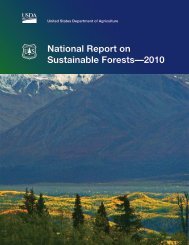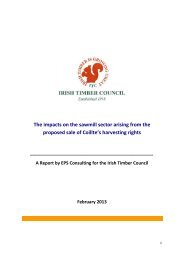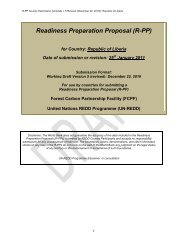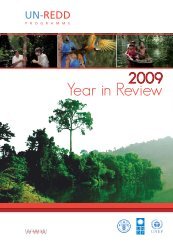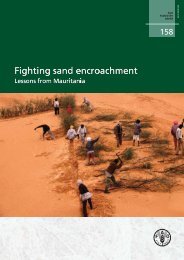pdf 1242 KByte - JIKO
pdf 1242 KByte - JIKO
pdf 1242 KByte - JIKO
You also want an ePaper? Increase the reach of your titles
YUMPU automatically turns print PDFs into web optimized ePapers that Google loves.
Policy Paper: Assessing prerequisites for market-based REDD+ activities 27<br />
4 The integration of REDD+ in Emission Trading Systems<br />
If REDD+ activities are to generate credits, markets for such credits are needed. While the UN is still discussing<br />
whether REDD+ activities will be financed via carbon markets or through an international fund,<br />
individual schemes have already adopted individual positions towards the inclusion of REDD+ credits. In the<br />
following, we will briefly analyse the different REDD+ positions with particular attention to the readiness<br />
elements these schemes require REDD+ countries to fulfil for market participation.<br />
4.1 California’s Cap and Trade Programme<br />
With its Global Warming Solutions Act of 2006 (AB 32) the State of California established a programme to<br />
reduce California’s greenhouse gas emissions to 1990 levels by 2020. One central tool to reach this target is<br />
a cap and trade scheme, which will cover about 85% of the states greenhouse gas emissions. The scheme will<br />
extensively rely on offsetting allowing covered entities to fulfil up to 8% of their obligations through offsets,<br />
including internal offsets from Californian entities not covered by the scheme. In the first commitment period,<br />
entities will be allowed to fulfil up to 2% of their emission obligation with credits stemming from sector-wide<br />
emission reductions in developing countries. This limit will be lifted to 4% in the subsequent commitment<br />
periods. While this regulation can be expected to produce a large demand for sector-based offset<br />
credits, no sector has yet been approved for inclusion (Climate Action Reserve 2012).<br />
Art § 95994 of the cap and trade system`s final regulation order includes six general requirements for sectorbased<br />
crediting programmes, which can be ordered along the three readiness building blocks discussed<br />
above. Regarding technical readiness countries willing to participate need to have a transparent MRV system<br />
in place and have developed an emission reference level against which performance can be measured. There<br />
are also some requirements associated with institutional readiness of the host countries. Hence, eligible programmes<br />
need to have established requirements that ensure credits are real, additional, quantifiable, permanent,<br />
verifiable and enforceable, as well as a mechanism to ensure public participation and consultation.<br />
With regard to policy readiness, the regulatory order requires the host jurisdiction to develop a plan for reducing<br />
the emissions from the respective sector. One additional requirement that may not always be applicable<br />
takes into account the fact that emission reductions achieved through project activities might have to be<br />
reconciled with the overall sector-level accounting from the jurisdiction (CARB 2011). While these requirements<br />
do already provide general orientation, the regulation does neither specify how these requirements can<br />
be met nor which sector-specific requirements will further be relevant.<br />
The same holds true for the forestry sector, which will be the first sector to be included in the scheme. While<br />
REDD-specific regulations are still being developed, California signed Memoranda of Understanding with<br />
the states of Acre (Brazil) and Chiapas (Mexico) in November 2010. In February 2011, the REDD Offsetting<br />
Group (ROW) was established to develop recommendations on REDD regulations. On the one hand, the<br />
working group is examining the legal and institutional elements needed for California to recognize REDDbased<br />
emission credits. On the other hand, the technical experts are examining the legal, policy and technical<br />
elements (including social and environmental standards) sectoral REDD programmes should achieve in order<br />
to be recognized in California`s cap and trade scheme. ROW is expected to present its final recommendations<br />
in summer 2012 (ROW n.d.).<br />
Nicolas Kreibich, Christof Arens and Wolfgang Sterk<br />
Wuppertal Institute




